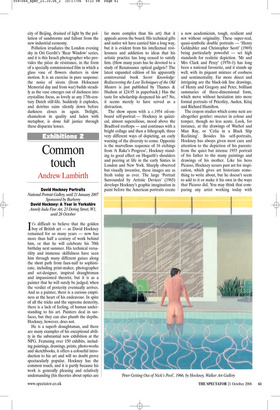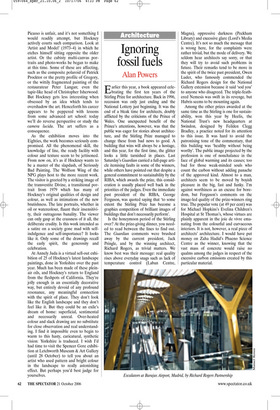Common touch
Andrew Lambirth
David Hockney Portraits National Portrait Gallery, until 21 January 2007 Sponsored by Burberry David Hockney: A Year in Yorkshire Annely Juda Fine Art, 23 Dering Street, W1, until 28 October It’s difficult to believe that the golden boy of British art — as David Hockney remained for so many years — now has more than half a century of work behind him, or that he will celebrate his 70th birthday next summer. His technical versatility and immense skilfulness have seen him through many different guises along the short path from faux-naïf to sophisticate, including print-maker, photographer and set-designer, inspired draughtsman and impassioned theorist, but it is as a painter that he will surely be judged, when the verdict of posterity eventually arrives. And as a painter, there is a curious emptiness at the heart of his endeavour. In spite of all the tricks and the supreme dexterity, there is a lack of feeling, of human understanding to his art. Painters deal in surfaces, but they can also plumb the depths. Hockney, however, does not.
He is a superb draughtsman, and there are many examples of his exceptional ability in the substantial new exhibition at the NPG. Featuring over 150 exhibits, including paintings, drawings, prints, photo-works and sketchbooks, it offers a colourful introduction to his art and will no doubt prove spectacularly popular. Hockney has the common touch, and it is partly because his work is generally pleasing and relatively undemanding (his theories about optics are far more complex than his art) that it appeals across the board. His technical gifts and native wit have carried him a long way, but it is evident from his intellectual restlessness and addiction to ideas that his artistic practice has long ceased to satisfy him. (How many years has he devoted to a study of Renaissance optical gadgets? The latest expanded edition of his apparently controversial book Secret Knowledge: Rediscovering the Lost Techniques of the Old Masters is just published by Thames & Hudson at £24.95 in paperback.) Has the taste for scholarship deepened his art? No, it seems merely to have served as a distraction.
The show opens with a c.1954 oil-onboard self-portrait— Hockney in quizzical, almost supercilious, mood above the Bradford rooftops — and continues with a bright collage and then a lithograph, three very different ways of depicting, an early warning of the diversity to come. Opposite is the marvellous sequence of 16 etchings from ‘A Rake’s Progress’, Hockney standing to good effect on Hogarth’s shoulders and peering at life in the early Sixties in London and New York. Sharply observed but visually inventive, these images are as fresh today as ever. The large ‘Portrait Surrounded by Artistic Devices’ (1965) develops Hockney’s graphic imagination in paint before the American portraits create a new academicism, tough, resilient and not without originality. These super-real, quasi-symbolic double portraits — ‘Henry Geldzahler and Christopher Scott’ (1969) being particularly powerful — set high standards for realistic depiction. ‘Mr and Mrs Clark and Percy’ (1970–1) has long been a national favourite, and it stands up well, with its piquant mixture of coolness and sentimentality. Far more direct and intriguing are the black-ink line drawings, of Henry and Gregory and Peter, brilliant summaries of three-dimensional form, which move without hesitation into more formal portraits of Priestley, Auden, Kitaj and Richard Hamilton.
The crayon studies which come next are altogether gentler: sweeter in colour and temper, though no less acute. Look, for instance, at the drawings of Warhol and Man Ray, or ‘Celia in a Black Slip Reclining’. Besides his self-portraits, Hockney has always given most care and attention to the depiction of his parents: from the quiet but intense 1955 portrait of his father to the many paintings and drawings of his mother. Like his hero Picasso, Hockney scours past art for inspiration, which gives art historians something to write about, but he doesn’t seem to add to it or make it his own in the ways that Picasso did. You may think that comparing any artist working today with Picasso is unfair, and it’s not something I would readily attempt, but Hockney actively courts such comparison. Look at ‘Artist and Model’ (1973–4) in which he etches himself sitting opposite the older artist. Or the cubisty multi-canvas portraits and photo-works he began to make at this time. Some of these are affecting, such as the composite polaroid of Patrick Procktor or the pretty profile of Gregory, or the wittily fragmented painting of the restaurateur Peter Langan; even the tapir-like head of Christopher Isherwood. But Hockney gets less interesting when obsessed by an idea which tends to overshadow the art. Henceforth his career appears to be peppered with lessons from some advanced art school: today we’ll do reverse perspective or study the camera lucida. The art suffers as a consequence.
As the exhibition moves into the Eighties, the work becomes seriously compromised. All the phenomenal skill, the knowledge of line, the ready facility with colour and texture seem to be jettisoned. From now on, it’s as if Hockney wants to be a master of the slapdash, of Seriously Bad Painting. The Wolfson Wing of the NPG plays host to the more recent work. The visitor is greeted by a striking image of the transvestite Divine, a transitional portrait from 1979 which has many of Hockney’s original qualities of design and colour, as well as intimations of the new brutishness. The late portraits, whether in oil or watercolour, flaunt their insensitivity, their outrageous banality. The viewer can only gasp at the crassness of it all, the deliberate crudity. Is this work intended as a satire on a society gone mad with selfindulgence and self-importance? It looks like it. Only some of the drawings recall the early spirit, the generosity and celebration.
At Annely Juda is a virtual sell-out exhibition of 25 of Hockney’s latest landscape paintings, done in Yorkshire over the past year. Much has been made of these pleinair oils, and Hockney’s return to England from the fleshpots of California. They’re jolly enough in an essentially decorative way, but entirely devoid of any profound resonance, any meaningful connection with the spirit of place. They don’t look like the English landscape and they don’t feel like it. But they could be an exile’s dream of home: superficial, sentimental and necessarily unreal. Over-heated colour and slack drawing are no substitute for close observation and real understanding. I find it impossible even to begin to warm to this hasty, caricatural, synthetic vision: Yorkshire is traduced. I wish I’d had time to visit the Spencer Gore exhibition at Letchworth Museum & Art Gallery (until 28 October) to tell you about an artist who used pattern and bright colour in the landscape to really astonishing effect. But perhaps you’d best judge for yourselves.



































































































 Previous page
Previous page